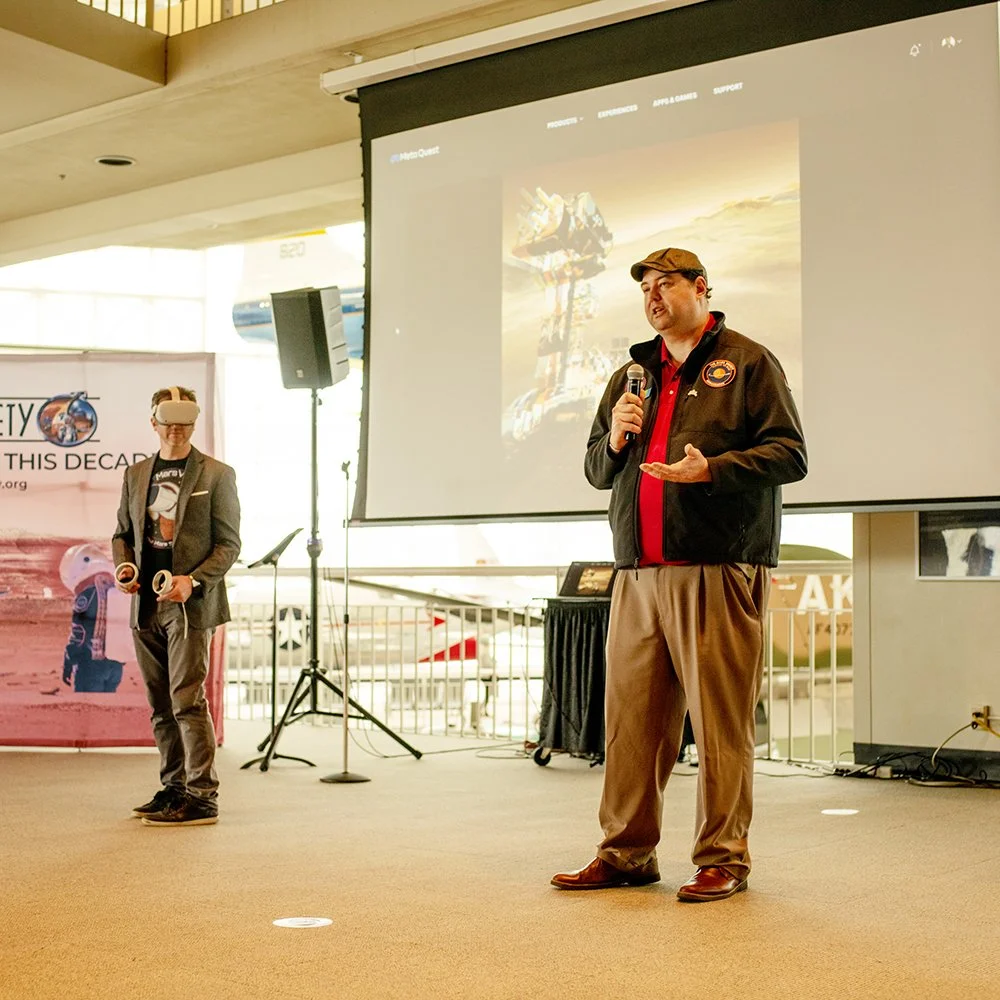MARS VR | Coordinated Field Operations
The Mars Society is undertaking a new initiative aimed at developing a prototype solution for real-time voice and data communications between an analog astronaut on EVA at MDRS and a remote user in a MarsVR simulation of MDRS. The prototype will serve as a technology demonstrator of collaborative field science between analog astronauts and remote users in a virtual reality environment.
PROJECT LEADS: James Burk + Jeff Rayner
James Burk (The Mars Society) and Jeff Raynor (MXT Reality) debut Mars VR at the Seattle Museum of Flight.
RATIONALE / HYPOTHESIS
Mars VR is expected to bridge the gap in communications between analog astronauts and remote off-site researchers, which is critical for collaborative research. Currently, there is no way to conduct joint collaborative, real-time research between analog astronauts in-simulation at MDRS and remote off-site researchers. The project is demonstrating fundamental technologies that could be used to address these gaps, and it is expected to inform potential follow-on efforts.
The Mars Society's initiative to develop a prototype solution for real-time communications between analog astronauts and remote users in a virtual reality environment is a significant step towards collaborative field science. With MarsVR’s Mars Comms application, virtual reality participants can explore the Mars-like terrain in real time, together in VR and with participants at the MDRS.
MARS VR PROJECT STRUCTURE
The Mars VR project is decentralized, open, and collaborative, adapted from open-source projects. Although all activities within the scope of the project will be funded by the Mars Society, all designs, documentation, and source code will be eventually released as open source.
SCOPE OF DEVELOPMENT
The project's functional scope will include one-way real-time data communications, bidirectional real-time voice communications, and VR simulation of MDRS for remote users.
MarsVR’s new Mars Comms application allows for VR participants to explore a digital twin of the Mars Desert Research Station in Utah, with a high-resolution terrain model and highly detailed models of the campus’ buildings (both inside and out). MarsVR has been in development for 5 years by the Mars Society and our partner MXTReality.
CREW 261 RELATED MARS VR WORK WITH EVALink
Crew 261 will be testing the EVALink, a proposed system, led by the Mars Society’s Chicago chapter, that aims to enable real-time field science by providing long-range, low-power digital connectivity over ad hoc mesh network topologies. This will enable short messages, such as an SOS, to be shared amongst users of the system, even if beyond line of sight. The system also aims to improve situational awareness by automatically collecting and aggregating location telemetry of crew members and displaying it in real time. Additionally, separated crew member groups can relay their positions and activities in real time to each other, enhancing situational awareness.
EVALink aims to improve science by allowing crew members to document samples and observations made in the field, in situ, using specialized end-point software that can be tailored for the type of science being conducted. The system also aims to enable coordinated science between analog astronauts on EVA in the physical world and virtual reality users in a digital twin of the same analog research facility.
SYSTEMS SPECIFICATIONS
The EVALink system includes wireless terminals, networking hardware, an on-premises server, and associated infrastructure and end-point application software. The system also includes an Electronic Laboratory Notebook (ELN) system that is open source and can save, store, and retrieve any of the data submitted by appropriately configured EVALink endpoint modules. Organizations sponsoring crew members may also provide their own ELN server.
The system also enables future extensibility opportunities, including IoT sensors and actuators, and fixed LoRa nodes around the MDRS compound.
For more information about the project, visit www.marsvr.com
